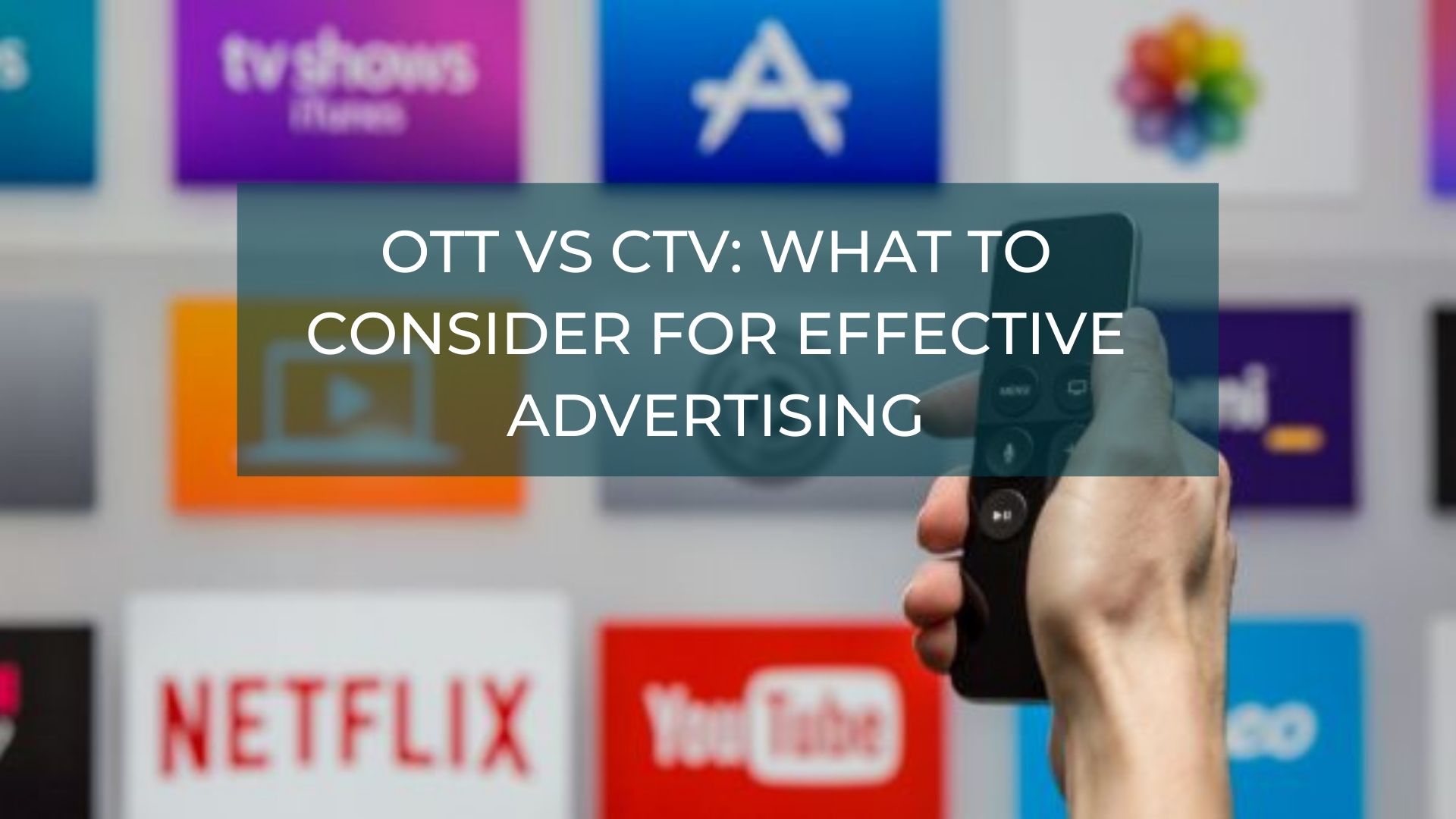
CTV for Advertisers: Fraud, Attribution, and Strategies | Podcast #1
December 21, 2021
OTT vs CTV: What to Consider For Effective Advertising
February 21, 2022
COVID-19 has completely changed the world. Fueled by lockdowns and restrictions, consumers’ TV consumption behaviours have significantly shifted towards on-demand TV from scheduled airtime TV. In 2021, 63% of all time spent on TV is on online streaming, and approximately 80 minutes per day is spent on advertising-based video on demand (AVOD). Connected TV, or CTV, is the underdog which has morphed into the hottest topic in AdTech–and with good reason.

Advertising on CTV is a $9 billion industry for marketers to reach households and individuals directly, and to target the right audiences throughout their marketing funnels. Together with the elimination of third-party cookies, it’s enticing for advertisers to invest in CTV advertising.
As an audience segmentation leader in the AdTech industry, AlikeAudience has extensive experience in helping advertisers drive massive reach and engagement with off-shelf or custom audience segments. In this article, we will guide you on choosing the right data vendor, developing ads your audience will engage with, and addressing privacy concerns in the CTV advertising space.
What is CTV advertising?
To answer “What is CTV advertising?”, let’s look at its definition. CTV advertising is programmatic advertising placed on any TV that is connected to the Internet, such as Smart TVs. CTV advertising can run on three main types of on-demand TV:
- Advertising-based video on demand (AVOD): AVOD refers to content that is available free for consumers, but the catch is that they need to watch advertisements. Examples include YouTube, DailyMotion, and even Facebook.
- Subscription-based video on demand (SVOD): SVOD refers to streaming services that consumers pay a monthly or yearly subscription fee to watch content. Examples include Netflix, and Hulu.
Transactional video on demand (TVOD): TVOD is the opposite of SVOD, where consumers buy content on a pay-per-view basis. Examples include Sky Box Office, and Apple’s iTunes.
Read more: CTV for Advertisers: Fraud, Attribution, and Strategies | Podcast #1
Why CTV is a massive advertising opportunity
CTV advertising space generates tremendous potential for advertisers, not just in the US but globally. The number of households in the US using CTV devices is projected to increase up to 113 million by 2024 and CTV ad spend in the APAC region is expected to grow by 34% over the next year, compared to 20% for the US and 21% for EMEA. Aside from this growing trend, what else does CTV advertising have to offer? Find out below:

Creating communal experiences
What sets CTV apart from other types of advertising is its ability to reach and engage multiple individuals at one time. Research shows that audiences watch on-demand TV on a large screen in the living room with friends or family, creating a more communal viewing experience. This allows advertisers to capture several “eyeballs'' using one advertisement, increasing the chances of reaching their target audiences. This is a different approach from other types of digital advertising which focuses on one-on-one relationships between content and consumers.
Reach massive audiences
CTV has skyrocketed in popularity among consumers offering more opportunities for advertisers to reach massive audiences. Since the onset of the pandemic, weekly time spent on CTV devices has escalated by 1 billion hours. By the end of 2020, there were 183.5 million connected TV viewers in the US, with the younger population from ages 25 to 54 making up 80% of viewership. But we’re also seeing an increasing number of older audiences switching over to CTV.
On top of this, connected TV devices are becoming more affordable and popular across the world. China leads the race in Asia with the highest Smart TV penetration rate of 76%. And the US saw an increase from 50% in 2014 to 82% in 2021 of households owning at least one internet-connected TV device.

Go cookie-less
CTV doesn’t rely on cookies, unlike the typical desktop and mobile ad campaigns. CTV has long based IP addresses to build household data graphs, and to identify and target audiences, which are called CTV Device IDs. Considering the recent crackdown on third-party cookies, and mobile identifiers, CTV provides a more future-proof ad solution.
AlikeAudience leverages partnerships with ID resolution partners such as TradeDesk, LiveRamp and Yahoo! to help CTV advertisers connect to their target audiences at scale on a household level.
Boost ad engagement
Advertisers can obtain valuable audience data from CTV Device IDs, such as behavioral trends, demographics, and psychographics, that can help them build more specific buyer personas and create ads that boost engagement with their target audience. Research shows that interactive CTV ads averaged a video completion rate of more than 85% in 2020, and that advanced creatives drew a 309% lift in engagement.

Considering that the advertising business is becoming more about trust and transparency, engagement is an important metric of ad effectiveness. Viewers will only devote their time, attention and data, if they perceive that they’re getting something valuable out of the advertisement.
Cost-effective
Generally speaking, it’s more cost-effective and flexible to reach premium networks with CTV advertising rather than linear TV. Most CTV ad providers offer flexible price structures, such as cost per metric or cost per completed view (CPCV). Advertisers running CPCV campaigns only need to “purchase” a view when the customer watches the whole advertisement.
But it’s still quite a costly venture to produce video advertisements and there is still a high entry barrier for small to medium enterprises entering the CTV ad space. In the coming years, it’ll be interesting to see how the CTV ad space evolves to break down those barriers and open up to every advertiser.
How advertisers can get the most out of CTV
Although CTV advertising offers benefits, the success of your advertising campaigns rely heavily on forming the right partnerships and knowing your target audience down to the core. In fact, 68% of marketers in the Innovid research says they’ve partnered with an advertising technology company, such as DSP, SSP or ad server to better measure CTV ad performance.
The strategies below can help you leverage CTV to reach the right audiences and boost return on ad spend:
Choose the right data vendor
Although CTV offers a massive pool of audiences, not all audiences are created equal. Advertisers need to nail down their audience segmentation strategies to find the right target audiences. This is where data partnerships come into play. Data vendors that offer accurate, scalable and privacy-compliant audience data with full transparency into the attribution process is just as important, if not more, as the medium.
AlikeAudience’s CEO and co-founder Bosco Lam presented thought leadership insights on CTV in the first episode of our AdTech podcast. He emphasizes that advertisers should ask these two questions before choosing data vendors in the CTV space:

Essentially, your data vendor shouldn’t be your attribution partner. Advertisers need to be clear about the roles of different solution partners and how they contribute to their campaign effectiveness, before choosing their data vendors.
AlikeAudience has always embraced collaboration with media partners and DSPs to demonstrate the value of our audience data which is then measured by an independent attribution partner. We never grade our own homework, but we work collaboratively with others who can, leading to successful, high ROAS campaigns.
Selecting the right ID resolution partner
Advertisers need to prepare and think through the ID resolution that they want to work with for audience targeting and measurement. Even though CTV is cookieless, there’s speculation that IP addresses will face the same fate of third-party cookies since it could be reverse engineered to identify specific consumers or households, leading to privacy issues. A straightforward alternative is to use the device IDs on the CTV platform or streaming service but you might run into some scale problems later on.
Advertisers should select partners that offer scale, accuracy and decent coverage in a specific country. LiveRamp’s RampID resolution is definitely one that checks all the boxes. It relies on hashed emails to build household graphs, allowing marketers to link different devices together using a single currency for a truly omnichannel strategy.

AlikeAudience has adopted RampID, as well as Unified ID 2.0 and ConnectID, and we’re ready to work with marketers who wish to enter the CTV space.
Read more: AlikeAudience Supports Unified ID 2.0, Ushering in a New Era of Identity
Engaging your target audience with the right creatives
There are several factors to consider when producing creatives for CTV advertising. The first is the overall theme. Since CTV is more of a communal platform mostly shared by families, your CTV ad creatives should be family-friendly.
Marketers also need to consider who the right audience set in a household is to drive campaign effectiveness. Creatives should not only engage the target audience, but also the decision makers in a household, e.g. parents vs. kids.
As more players emerge in the CTV ad space, it’s exciting to see how marketers will adapt the functionality of their creatives to engage customers based on the unique environment of each platform they’re advertising on.
Conclusion
CTV definitely offers an exciting new frontier for advertisers. But there needs to be the right support system as a guiding map, in terms of audience targeting strategies, and data partnerships, to navigate it successfully.
With more than 7000 audience segments collected from 1 billion unique devices across 13 countries, AlikeAudience support advertisers and marketers with high-performing, privacy-compliant, and global audience segments at scale to boost return on ad spend through CTV advertising. AlikeAudience has also recently been recognized as one of the Top 10 Ad Management Solution Providers 2022 in APAC with a strong presence in the US market.
Contact our data strategist to get started with the audience data you need for integrating CTV into your advertising campaigns today. Don’t forget to check out our CTV podcasts on fraud, attribution and strategies, and stay tuned for the next episode on CTV in the APAC region in the next few weeks.
